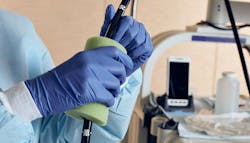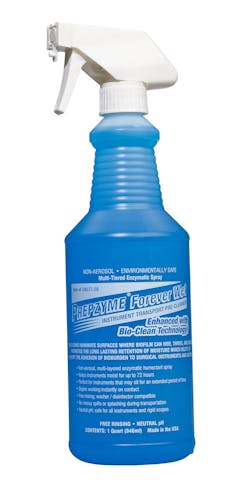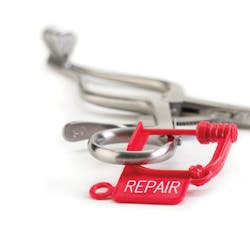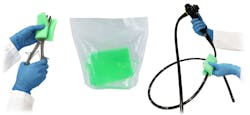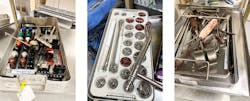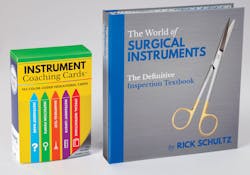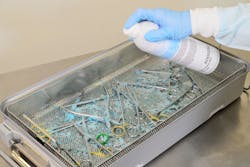While COVID-19 has shaken the foundation of healthcare delivery in the U.S., changing the way care is delivered in many ways, there is one thing that remains the same – the need to effectively and efficiently reprocess soiled instruments and devices. Furthermore, the challenges remain the same, most notably device pre-cleaning in the operating room (OR) or other procedural area, which makes it easier for central sterile/sterile processing department (CS/SPD) professionals to remove stubborn debris and bioburden when the items arrive in decontamination.
“Often, facilities are required to move employees to different areas of responsibility or hire temporary employees to meet the needs to provide patient care,” she stated. “In either case it is difficult to ensure they are trained appropriately to perform the critical tasks of instrument reprocessing preparation. Many facilities have also had to rearrange clinical areas to meet the needs for the influx of patients. As a result, procedures may have been moved to different locations. The new locations may not be designed with the appropriate environment for the pre-cleaning and reprocessing of instruments.”
“The practices haven’t really changed, but the focus on ensuring the compliance of pre-cleaning has been more intense,” said Mary K. Lane, MHA, CSPDM, CSPDS, CSPDT, MK Lane SPD Consulting. “Additionally, there has been a lot more attention placed on ensuring that all soiled items transported are covered appropriately and/or transported in the correct solid leak-proof containers, and that staff transporting the soiled devices are wearing the correct personal protective equipment (PPE).
Seth Hendee, CRCST, CIS, CHL, CER, CSPDT, CFER, IAHCSMM Approved Instructor, Clinical Education Coordinator, SPD, Heathmark Industries, says that while SARS-CoV-2, the virus that causes COVID-19, is no harder to kill than many other viruses, those staff members performing pre-cleaning must be cautious if aerosols or the potential for aerosols are present in the pre-treatment process, such as when cleaning some flexible endoscopes.
“Increasing air exchanges and performing steps under some sort of cover are novel ideas that may have some effect,” said Hendee. “As with many new challenges to hospitals, a risk assessment performed with input from a multidisciplinary committee should be conducted to decide the best course of action.”
“Add the personal and professional stressors of a global pandemic to the mix and finding ways to improve a subpar pre-cleaning process may seem impossible, but sterile processing and perioperative leaders must be up for the challenge because effective point-of-use cleaning has a direct impact on patient safety.”
Start with IFUs and industry standards
Hendee says understanding the level of pre-treatment directed by each instrument’s instructions for use (IFU) is the first step towards improving the process.
“Surgical cases can have instruments of extremely varying complexity, with the range of pre-treatment steps being just as varied,” said Hendee. “Pre-treatment of an instrument may be as simple as wiping gross debris from the external surface or disassembling a device. On the other hand, it could also be complex and require multiple measured steps, as in the case of flexible endoscopes. Understanding the requirements outlined in the pre-treatment portion of the IFU will require point-of-use staff to review and train on those directions. Facilities wishing to have a quality pre-treatment process will find a way to make this happen.”
Juan Ramos, Aesculap CSD Lead Consultant, BSBA, CRCST, CIS, CHL, LGBC, points to “the holy grail” of surgical instrument reprocessing, ANSI/AAMI ST79:2017, as a prime resource for information on point-of-use preparation of surgical instruments. He recommends that health facilities base processes and policies on these standards, noting how section 6 of the standard discusses point-of-use cleaning of medical devices (AAMI, 2017).
“Having a best practices program in place for the point-of-use preparation of surgical instruments can help ensure compliance with voluntary and regulatory agencies; decrease turnaround time of surgical instruments; and preserve the value of your surgical instruments,” said Ramos.
Being too busy is no excuse
In facilities where pre-cleaning process compliance is low in the OR, the excuse often given by staff members is they can’t perform the necessary steps in the short time provided to turn around the room for the next case.
“Point-of-use cleaning in the OR should be ‘standard work’ for every person responsible for the instrumentation,” said Gregg Agoston M.B.A., Vice President Business Development, SPD Transformation Services, SpecialtyCare. “Time pressures to quickly turn over rooms, unless it is an emergency situation, should never be an excuse for improper pre-cleaning. If time pressure is given as the reason why pre-cleaning cannot be performed; then a formal review of the processes should be done to find the root cause.”
Megan Pietura, Business Operations Manager, Pure Processing, recommends that the OR and CS/SPD teams start with a clear and well-defined definition for what is considered “clean” in terms of the condition of instruments arriving in decontamination. Through this process they can identify conflicting expectations.
“Establishing best practices among OR and SPD staff can be challenging, because each person has a different relationship with their instruments, and what clean really is, meaning what’s clean to OR might not be clean to SPD, and vice versa,” she stated. “You can’t understand each other if you’re not speaking the same language.”
To help improve point-of-use cleaning compliance in the OR, Rick Schultz, President, RMPS Publishing, and author, inventor, lecturer in the field of sterile processing, suggests that OR staff use a checklist to mark off pre-cleaning steps after each and every case.
“Operating room personnel have so many urgent responsibilities at the end of every surgery, like turning over the operating room, that proper pre-cleaning of the instruments and devices, unfortunately, becomes low on the priority list,” said Schultz. “A checklist would help ensure all instruments and devices are getting properly cleaned before they go to the CS/SPD.”
The importance of education and training
OR staff members’ lack of understanding of the instrument reprocessing steps in the CS/SPD is another factor cited for improper pre-cleaning. CS/SPD professionals often witness frustration among OR surgeons and other clinicians when they believe the process is taking too long. By educating the OR on the challenges and complexity of device reprocessing, and how failure to pre-clean can prolong the process, the CS/SPD can help correct some of the confusion that leads to clashes between the two departments.
“Instrument pre-cleaning is often overlooked if the process is not optimized or if education is not provided to the staff responsible for pre-cleaning,” said Ann Mangskau, Marketing Manager Ecolab Healthcare. “A key to ensuring proper pre-cleaning processes are followed is to educate OR staff about how proper pre-cleaning prevents damage to instruments and improves the removability of soils. Staff in the OR have an interest in making sure the instruments stay in good working condition and are clean and knowing the ‘why’ behind the task empowers them.”
As patient care and safety are the number one priorities of the OR team, Lynn Burbank, DNP, RN, CRNP, Global Senior Manager for Infection Prevention, Olympus Corporation of the Americas, stresses the need to educate them on how pre-cleaning helps the CS/SPD deliver instruments that are safe and effective for use.
“One factor inhibiting users from performing this task is lack of awareness of pre-cleaning’s importance to patient safety,” said Burbank. “Pre-cleaning at the point-of-use is recommended by the U.S. Food and Drug Administration (FDA) to ‘prevent drying of soil and contaminants in and on the device’ and to ‘facilitate subsequent cleaning steps.’ Immediate removal of microorganisms on the surface of a device prevents development of bioburden, which cannot be eliminated through high-level disinfection or sterilization.”
Because devices are so varied in design and complexity, Schultz says point-of-use pre-cleaning can be compromised by lack of staff knowledge around how to clean various items used in patient procedures.
“Medical devices range from simple-to-clean such as hemostats and scissors, where operating room personnel are taught to separate the rings and wipe with a moist sponge, (preferably not saline) to difficult laparoscopic instruments that need to be disassembled, wiped and flushed,” he stated. “A challenging instrument to effectively pre-clean is a Kerrison Rongeur. Some of these instruments have the ability to be taken apart and others do not come apart, but all need to be pre-cleaned just the same. The overall solution to this challenge is education.”
Proper training in the OR and CS/SPD is particularly critical during the pandemic when facilities experiencing staff shortages are having to bring new employees up to speed, explains Pate.
“The orientation of new employees to the processes of pre-cleaning instruments is vital,” she said. “If there is a new employee or an employee that is working in the re-processing area for the first time, the facility must ensure they receive extensive education and training prior to beginning work. Although it takes increased time to properly educate and train employees, the benefits outweigh the risk.”
During the pandemic, and times of “business as usual,” a strategic training strategy is the foundation of all successful processes and policy adherence, says VanHee. When implementing improved pre-cleaning policies, he recommends that CS/SPD and OR leaders work together to communicate the value and benefit of the new policies, host training sessions with all the staff that is involved in the process, and schedule follow-up training and communication.
“It is especially important to include everyone that is affected by the new policy or procedure in all communication and training provided during process implementation,” said VanHee. “Great plans fail too often because only a portion of the staff involved in the process were trained, not only on the process itself, but on the benefits to the team and patients that they serve.”
Steps to safe and effective pre-cleaning
Pre-cleaning can start during the procedure, should take place immediately after the case ends, and steps should be taken to keep instruments and devices moist during transport to decontamination, which eases CS/SPD staff removal of remaining bioburden.
Here are some best practices from industry experts on pre-cleaning success at each stage of the process:
During the procedure
- Clean each instrument of gross debris after each use.
- This can be done by wiping the surfaces with a lint-free cloth or sterile surgical towel moistened with sterile water (not saline).
“Ensuring that the OR is stocked with the correct supplies for pre-cleaning is critical,” said Agoston. “Sterile water and a sterile towel or sponge should be used during the procedure to remove gross debris. Saline should not be used as it can cause corrosion to metal. If enzymatic solutions or foams are to be used at the end of the surgical procedure, these must be stocked in the OR. If the instruments require suctioning or priming with enzymatic solution (e.g., flexible endoscopes/Da Vinci Instruments), the solutions and accessory items must also be stocked in the room. It is important to verify in the IFU the correct volume of enzymatic solution to suction or prime the lumens.”
Burbank says staff understanding of pre-cleaning detergents and cleaning product mechanics supports best practice. She explains how appropriate detergent selection should be based on the device manufacturer’s IFU, noting how neutral pH, enzymatic detergents are a common choice when cleaning devices instead of detergents with high pH (alkaline), which can cause damage to the items.
“Another recommendation is the use of lint-free clothes or wipes,” said Burbank. “Use of a cotton-based product, such as a gauze pad, can leave small fibers (lint) that can potentially attract microbial growth. Providing robust education on products used during reprocessing helps users understand how their actions are critical in preventing infections and possible damage to equipment.”
Immediately following the procedure
- Apply pretreatment solution to all instruments immediately following the procedure or as the patient exits the procedure room, according to the manufacturers’ IFUs.
- Place all devices back in their original containers or trays to prevent damage during transport and support process efficiency in the CS/SPD.
- Heavier, more durable instruments should be placed on the bottom of the tray and lighter, more delicate instruments on top to minimize the risk for damage.
“The devices should be opened during pre-cleaning and complex instruments should be disassembled according to the manufacturer’s IFU,” said Ramos. “Post procedure, clinical staff should latch sharp instruments on the first box lock notch and remove and discard all sharps in the designated biohazard containers to help ensure safe handling.”
Agoston explains how many hospitals use a spray foam or liquid enzymatic solution to pre-treat the instruments prior to transporting to the decontamination area. He says in order for these products to be effective, the person applying them must ensure the instruments are thoroughly coated with the product following the manufacturer’s IFU.
“The biggest challenge we see in hospitals is ineffective spraying,” said Agoston. “To be effective, the instruments must be thoroughly coated with the pre-treatment. Lumens are a particularly difficult area to clean. Da Vinci instruments require that the lumens be primed with enzymatic solution and flexible endoscopes require that enzymatic solution be suctioned through the instrument lumens in the OR prior to transporting.”
During transport
- Instruments should be transported to the decontamination area in a closed, rigid container or enclosed transport cart.
- Instruments should be kept moist according to their manufacturers’ IFUs.
“The container or cart should be leak-proof and labeled with a red biohazard sticker,” said Ramos. “Biohazard labels should be affixed to the transport device to prevent separation from the contents. Contaminated instruments and other items should be separated from clean and sterile supplies before transport to the processing area.”
Arrival in decontamination
By the time instruments arrive in decontamination, the pre-cleaning process should have been well underway due to the efforts of OR staff at the point-of-use. To improve productivity among CS/SPD staff members, Pietura recommends that hospitals focus on both personnel and process.
“Productivity and employee satisfaction are improved when the CS/SPD has the proper tools to ease labor efforts and address safety considerations, such as ergonomics,” she said. “That alone helps with the high turnover rates in sterile processing departments that lead to even more bottlenecks in productivity.”
Agoston notes how some hospitals separate instruments that have been “used” from those that were “unused” in the procedure, explaining the drawbacks of this approach:
“All instruments should treated as if they are contaminated when returned from the OR. The cleaning processes should be identical for all instruments, regardless if they were used or not used during the surgical procedure. Additionally, separating instruments from their original set can make the assembly process more difficult, increasing the chance of errors.”
Tips for compliance and continuous improvement
In the busy OR environment, it is easy for staff members to overlook the importance of instrument pre-cleaning when faced with the pressures of patient care. Hospitals must take steps to reinforce education and training, drive policy compliance and hold staff members accountable for their actions (or lack of action).
Lane stresses the importance of communication and support from leadership to drive compliance with pre-cleaning protocols.
“When support is gleaned, staff are typically held accountable and the lack of pre-cleaning is reduced greatly,” she stated. “Submitting safety reports or completing audits on the case carts or instrumentation sent to SPD is a great method to track compliance. Of course, this requires additional work initially on SPD staff in the decontamination area and the SPD leadership as it relates to the documenting, but typically it subsides quickly as the staff responsible for improper pre-cleaning are held responsible by their leadership.”
Lane adds that buy-in and support from infection prevention is also critical to long-term success.
“Obtaining their support has gotten much easier over the past several years as The Joint Commission has placed a great deal of focus in this area and has issued many findings as it relates to improper or lack of pre-cleaning of medical devices,”she elaborated.
With all of the variety of instruments and devices that flow in and out of the OR, staff members can benefit from ongoing educational tools on proper pre-cleaning and equipment to help them have what they need at hand in terms of cleaning supplies, explains Mangskau.
“Using tools like a process wall card provides reminders on the proper procedure. In addition, tailoring the pre-cleaning process to fit the existing OR workflow and making sure pre-treatment products are available at the point-of-use can also drive process improvement and help ensure pre-cleaning processes are followed. Products can ‘walk away’ from their location, so installing a wall rack to hold the bottle can help keep it in the right location, ready for use.”
Agoston recommends hospitals have an established formal error reporting system that tracks errors in instrument reprocessing both in the OR and CS/SPD.
“Management must closely monitor this information and implement corrective action as needed,” he said. “Notification to the OR team that returned improperly prepared surgical instruments is just as critical as reporting errors made by the SPD. Education to both the OR and SPD staff is critical to ensure that instruments are available, functional and safe to use for each surgical procedure. SpecialtyCare has a trained and experience LEAN Six Sigma trained staff that can help hospitals identify the root cause of SPD/OR problems and develop effective solutions.”
About the Author
Kara Nadeau
Senior Contributing Editor
Kara Nadeau is Sterile Processing Editor for Healthcare Purchasing News.
